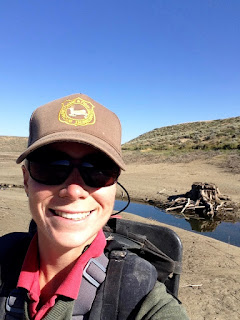As mentioned in an earlier blog or so ago, I will be attending two weeks of training in Logan and Moab, UT starting May 15th and ending May 26th. I just recently received a large document that details every aspect to everything step that we will be doing out in the field in terms of what we are sampling and how that is done. Today, I will not be blogging about it as I will leave that for another time since it is very extensive and I am not too sure that I am allowed to share its' contents. So instead I will probably just end up outlining it which might make more sense. HAHA
Here is the outline for the two week training and boy it is a lot to think about and I am praying that the weather will be good the entire time since we all will be camping out every night except for the 19th, 20th, and 21st.
May 15th
Here is the outline for the two week training and boy it is a lot to think about and I am praying that the weather will be good the entire time since we all will be camping out every night except for the 19th, 20th, and 21st.
May 15th
- Arrive at USU Logan, UT campus for introductions and BLM background and introduction to AIM
- Discuss critical concepts such as landscapes and bankfull, floodplain height, scour line, and thalweg indicators.
- Then we will head over to the field training site and do an exercise on the topics just disgust in class.
May 16th
- Learn how to use an iPad for data collection in the classroom before heading out to the field.
- The rest of the day, we all split up into groups to learn/preform four different concurrent training modules.
- Initial site procedures: site verification, GPS points and photos, measuring bankfull width, setting up transects
- Water quality and benthic macroinvertebrates: benthic macroinvertebrate sampling and sample preservation, grab samples, YSI sonde use
- PHAB Part 1: bankfull width, bankfull height, floodplain height, canopy cover
- PHAD Part 2: substrate, bank cover and stability
May 17th
- Here we will consist of four different concurrent modules
- Vegetative and riparian cover
- Pools
- Slope
- Flood-prone width, LWD, human influences
May 18th
- This day we end up working with our fellow crew members, mine will be Keenan how is the lead technician for Kemmerer, on practicing PHAB and calibration. There will be five different stations to be rotated through once one is completed.
- Channel dimensions: bankfull height and width, floodplain height and width
- Human influence and bank cover and stability
- Pools and LWD
- Riparian cover and densiometer
- Slope
- Once those stations are done, we can continue onto contingent indicators such as turbidity, thalweg and fish cover.
May 19th
- Before leaving for Moab in the afternoon, we all come together and have a discussion about the past four days and learn about special situations and sliding river banks and about data entry into the computers.
May 20th and 21st
- All of the technicians are required to take a Wilderness First Aid class at the USU in Moab, UT. We pretty much learn about all of the different situations we might encounter from dehydration, hypothermia, open cuts, ect.
May 22nd
- In the morning out at camp about 45 minutes away from Moab, we get a "Welcome to the West" discussion including safety, the size of the landscape, weather patterns, public lands and camping, gates and cattle, and 4x4 driving. Once we are finished with that then we head out and set up practice reaches.
- The rest of the day is spent putting everything we learned in Logan to use.
May 23rd to 24th
- These days are spent collecting all of our data just like we will be doing in the field all summer.
May 25th
- Here we will travel to different steams and observe the differences between those and what we just did. In the afternoon, we will learn about how to handle different public engagement scenarios such as ranchers, private landowners, fisherman, BLM staff, and random people.
May 26th
- We finally make it to our last day of training! This is we were will wrap-up discussions, answer questions and turn in gear. By two pm we will be out of there and heading back home.
I know that this training is going to be very beneficial and am just hoping that I am able to understand everything. The entirety of this training is going to lead us to doing our job 100% correct with very little uncertainty.


Comments
Post a Comment